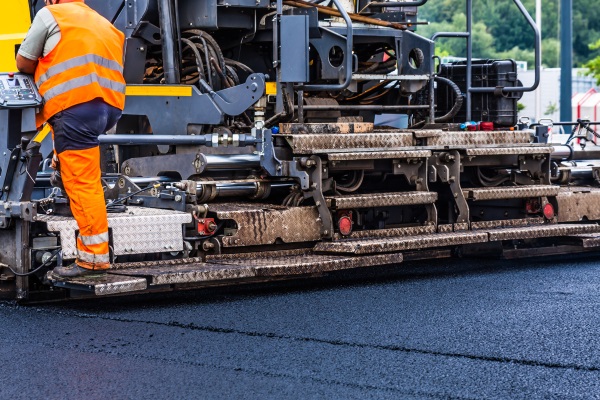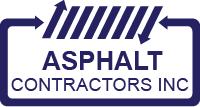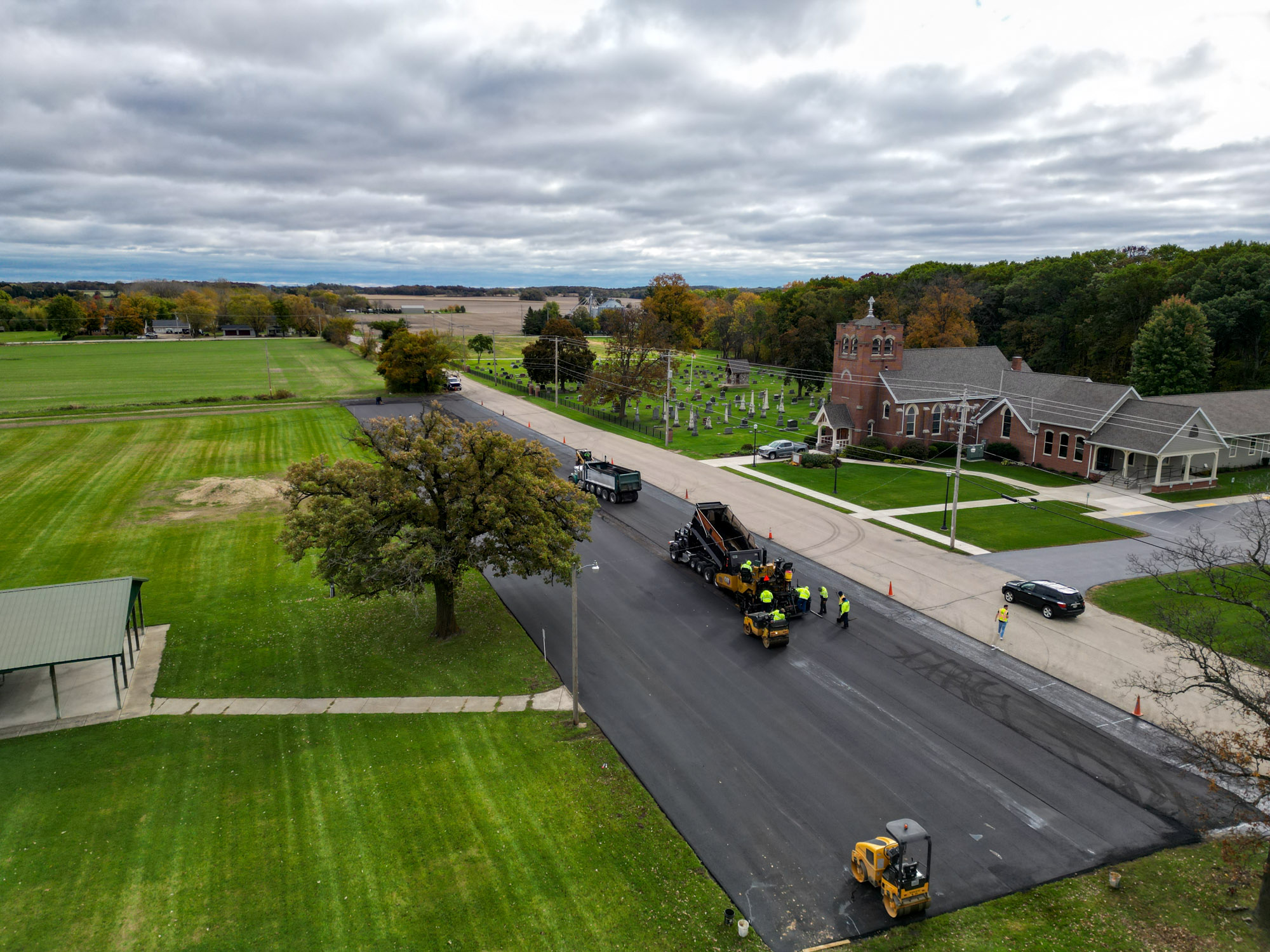Why Thickness Decisions Matter for Heavy Traffic Lots

Designing a parking lot that stands up to heavy traffic is not just about choosing asphalt and getting it down quickly. The right pavement thickness is the backbone of a long-lasting lot that resists rutting, cracking, and costly failures. When buses, delivery trucks, semi-trailers, and forklifts use your property daily, axle loads and tire pressures put intense stress on the pavement structure. A smart design spreads that stress through the asphalt layers, base, and subgrade so the surface stays smooth and safe for years.
The parking lot thickness chart on this page gives you practical ranges to start planning. It accounts for the traffic mix, base construction, and subgrade support that matter most under heavy loads. With more than four decades of experience in Southeast Wisconsin, Asphalt Contractors Inc. has built and maintained countless heavy-duty lots that perform in tough freeze-thaw conditions. Use this guide to frame your project, then work with our team to finalize a design that fits your site and budget.
Parking Lot Thickness Chart for Heavy Traffic
This parking lot thickness chart is a planning tool based on common heavy-traffic conditions in the Upper Midwest. Actual designs should be confirmed with a pavement engineer after reviewing soil strength, drainage, and traffic counts. The ranges below assume quality materials and proper compaction.
Category A: Frequent buses and delivery trucks
- Typical use: grocery stores with frequent box trucks, school bus loops, retail service lanes, hotel drop-off lanes with tour buses
- Asphalt surface course: 2.0 to 3.0 inches of dense-graded mix designed for heavy traffic
- Asphalt binder course: 3.0 to 5.0 inches of a stable base mix
- Crushed aggregate base: 8 to 10 inches of well-graded, angular stone compacted to specification
- Stabilized subbase when needed: 4 to 6 inches of cement treated or asphalt treated material if subgrade is weak or wet
- Total structural thickness: 13 to 24 inches depending on subgrade strength and drainage
Category B: Semi-truck lanes and loading docks
- Typical use: warehouse approach lanes, truck circulation paths, distribution centers, retail loading docks, waste collection routes
- Asphalt surface course: 2.5 to 3.5 inches with a high-performance mix that resists rutting
- Asphalt binder course: 4.0 to 6.0 inches of heavy-duty base mix
- Crushed aggregate base: 10 to 12 inches of crushed stone or recycled concrete aggregate
- Stabilized subbase when needed: 6 to 10 inches where subgrade CBR is low or drainage is poor
- Total structural thickness: 17 to 32 inches depending on load repetition and subgrade support
Category C: Heavy industrial yards and slow, high-load areas
- Typical use: manufacturing yards, intermodal staging, forklift routes, staging areas with heavy static loads
- Asphalt surface course: 3.0 to 4.0 inches, consider polymer-modified or stone matrix asphalt for surface durability
- Asphalt binder course: 5.0 to 7.0 inches for added stiffness and load distribution
- Crushed aggregate base: 12 to 16 inches of well-graded stone with strict moisture and density control
- Stabilized subbase when needed: 8 to 12 inches, often with geogrid reinforcement on weak subgrades
- Total structural thickness: 20 to 39 inches depending on subgrade and moisture conditions
Category D: Fire lanes, hospital loops, and transit routes
- Typical use: emergency vehicle routes that must carry occasional but heavy loads
- Asphalt surface course: 2.0 to 3.0 inches
- Asphalt binder course: 3.0 to 4.0 inches
- Crushed aggregate base: 8 to 10 inches
- Stabilized subbase when needed: 4 to 6 inches for added reliability on weak soils
- Total structural thickness: 13 to 23 inches depending on subgrade and drainage
If your project requires concrete pavement, Asphalt Contractors also installs jointed concrete designs for heavy traffic. Typical slab thicknesses range from 7 to 10 inches on a compacted base, with dowels and joints detailed for load transfer. Our concrete team can advise where concrete is a better fit, such as dock aprons and dumpster pads exposed to steel-wheeled equipment.
How Subgrade Strength Changes the Chart
Subgrade capacity drives base and subbase thickness. A strong, well-drained sandy gravel needs less total structure than a wet clay. In practice, engineers often classify the subgrade by California Bearing Ratio or resilient modulus. While you do not need lab numbers to start planning, you should understand how soil conditions shift the parking lot thickness chart.
- Very weak subgrade, such as saturated clay: expect to add 6 to 12 inches of stabilized subbase or use geogrid under the base. Consider underdrains to lower the water table.
- Moderate subgrade, such as silt or silty sand: keep base on the higher end of the ranges, and add 4 to 6 inches of stabilized subbase if proof rolling shows deflection.
- Strong subgrade, such as sandy gravel: you can be closer to the lower end of base and subbase ranges, but still manage water and provide separation from fines.
- Rocky or very firm subgrade: reduce subbase, but still use a separation fabric if there is a risk of fines pumping into the base.
Asphalt Contractors recommends proof rolling the prepared subgrade with a loaded truck. Areas that deflect or weave under load should be undercut and replaced, or stabilized before base placement. This step protects your investment more than any small change to asphalt thickness.
Drainage, Climate, and Wisconsin Conditions
Moisture destroys pavement structures faster than cold. In Wisconsin, freeze-thaw and spring thaw cycles magnify the effect. Good drainage is essential for any heavy-traffic design. The thicker the section, the more important it is to keep water out of the layers. Proper drainage also makes your parking lot thickness chart more reliable, because materials will behave closer to lab conditions.
- Provide surface slopes of 1.5 to 2 percent to shed water quickly.
- Use positive grades to direct flow to inlets without ponding.
- Install edge drains or underdrains where water can migrate into the base.
- Separate fines with geotextile to reduce pumping at joints and cracks.
- Consider permeable base or open graded drainage layers only when you can collect and remove the water via underdrains.
Asphalt Contractors builds heavy-duty lots across Racine, Kenosha, Walworth, Waukesha, and Milwaukee counties. Our teams plan for snow removal practices, spring thaw restrictions, and salt use so your pavement holds up season after season.
Material Options That Improve Performance
Asphalt mix choices that resist rutting
Heavy wheel loads and turning movements can rut soft mixes. For truck lanes and loading docks, select mixes built for stability and durability. In our region, performance-graded binders such as PG 58-28 or PG 64-28 are common. For high-shear zones, polymer-modified binders or stone matrix asphalt can add rut resistance and surface life. Asphalt Contractors manufactures our own asphalt, which gives us tight control over gradation, binder content, and consistency. That helps your project meet the design intent behind the parking lot thickness chart.
- Use dense-graded surface mixes with high angular stone for heavy traffic.
- Increase binder course thickness to distribute loads more effectively.
- Specify a quality tack coat between lifts to bond the structure together.
- Limit lift thickness to what can be compacted to target density with available rollers.
Base and subbase choices that add strength
Base material carries much of the load in heavy-traffic lots. Well-graded, angular aggregate provides interlock and stiffness when compacted correctly. Recycled concrete aggregate and crushed asphalt can perform well if processed and tested to meet specifications. Asphalt Contractors operates milling and crushing equipment, allowing us to produce uniform base materials that compact to high densities. That control reduces variability and supports the thickness ranges in the chart.
- Use 100 percent crushed aggregate with fines limited to maintain drainage.
- Compact in thin lifts to achieve targeted density and stiffness.
- Use geogrid reinforcement over soft subgrades to reduce base thickness where appropriate.
- Stabilize with cement or asphalt emulsion when subgrade moisture is hard to control.
Edges, joints, and transitions
Heavy trucks stress edges and joints more than cars. A durable design includes thicker edges or concrete curb and gutter to protect the pavement. At loading docks and dumpster pads, consider a concrete apron over a thicker base to handle point loads. Transition joints should be keyed and well bonded to avoid differential movement.
Step-by-Step: How to Use the Parking Lot Thickness Chart
- Define traffic: List the heaviest vehicles that will use your lot and how often they appear. Separate car-dominant areas from truck lanes and docks.
- Check subgrade: Review soil maps, past construction records, or perform test pits. Schedule a proof roll to confirm support under load.
- Select a category: Choose from the heavy-traffic categories in the parking lot thickness chart that best match your use. If two seem close, pick the higher option for critical areas.
- Choose base strategy: Decide whether to use a thicker aggregate base, a stabilized subbase, geogrid reinforcement, or a combination.
- Plan drainage: Add surface slopes, underdrains, and separation fabrics to keep the structure dry.
- Detail materials: Set mix types, lift thickness, and tack coat application rates. Identify areas that need upgraded materials, such as stone matrix asphalt or concrete aprons.
- Build in quality control: Specify density targets, testing frequency, and surface tolerances. Require proof rolling and corrective actions before paving.
- Schedule maintenance: Plan for sealing, crack repair, and resurfacing intervals based on traffic and mix selection.
Construction Quality Counts as Much as Thickness
Even the best parking lot thickness chart will not save a project built with poor compaction or wet materials. For reliable performance, insist on proper lift thickness, calibrated rollers, and density testing. Tack coat every asphalt-to-asphalt interface so layers act as a single structure. Ensure base material is compacted to specification at the correct moisture content. Asphalt Contractors uses top-tier pavers, rollers, and testing protocols. Our certified crews follow Wisconsin best practices to deliver consistent density and smoothness, which is critical for heavy traffic areas.
Common Causes of Early Failure and How to Prevent Them
- Underestimating truck traffic: Separate truck lanes from car parking and design each area appropriately.
- Thin base on weak soils: Increase base or add stabilization to prevent flexing and pumping.
- Poor drainage: Design out standing water and install underdrains where needed.
- Inadequate compaction: Require target densities and confirm with testing.
- Skipping tack coat: Bond every asphalt lift to share loads and stop slippage.
- Opening too soon: Allow cooling and strength gain before heavy traffic enters.
- No edge protection: Use curb, gutters, or thickened edges to prevent edge break.
Maintenance Plan for Heavy-Traffic Lots
Heavy vehicles magnify small defects over time. A simple maintenance plan can extend life by many years. Seal cracks annually to keep water out of the base. Sealcoating is not a structural fix, but it protects against oxidation and improves appearance when timed correctly. For localized rutting or alligator cracking, mill and replace the damaged area rather than simply overlaying. When wear is uniform, plan a mill and overlay that restores the surface course. Asphalt Contractors offers maintenance, milling and pulverizing, and resurfacing services tailored to the traffic and condition of your lot.
- Annual inspection and crack sealing
- Targeted patching of distressed areas
- Sealcoat cycles based on exposure and use
- Mill and overlay to renew heavy-traffic lanes before structural damage spreads
Why Partner With Asphalt Contractors
Asphalt Contractors Inc., established in 1979, is a full-service paving contractor based in Union Grove, Wisconsin. We design and build heavy-duty parking lots that meet the needs of retailers, schools, manufacturers, and logistics facilities. Our team handles asphalt paving, maintenance, milling and pulverizing, concrete construction, site preparation, asphalt manufacturing, specialty services, and crushing. By manufacturing our own asphalt mixes, we deliver consistent quality and cost savings. Our certified crews use top-notch equipment and proven processes so your project is built to the intent of the parking lot thickness chart and the realities of your site.
We proudly serve Southeast Wisconsin, including Racine, Kenosha, Walworth, Waukesha, and Milwaukee counties. From preconstruction planning and budgeting to final striping, Asphalt Contractors manages the details that keep projects on schedule and within budget. For facilities with critical uptime, we phase work to keep your operations running and your customers safe.
Get a Custom Thickness Design for Your Project
The parking lot thickness chart on this page is a powerful starting point, but every site is unique. Traffic patterns, soil conditions, drainage, and climate exposure all influence the final design. Asphalt Contractors will meet on site, perform a pavement evaluation or soil review, and tailor a section that fits your goals. Where needed, we coordinate with pavement engineers for formal design packages and stamped plans. Whether your lot serves buses, delivery trucks, semi-trailers, or heavy industry, our team can build a pavement structure that performs.
Ready to plan your heavy-traffic parking lot. Contact Asphalt Contractors for a consultation and a project-specific thickness recommendation. We will help you apply the parking lot thickness chart to your site, choose the right materials, and build a durable pavement that holds up to Wisconsin weather and heavy loads.


